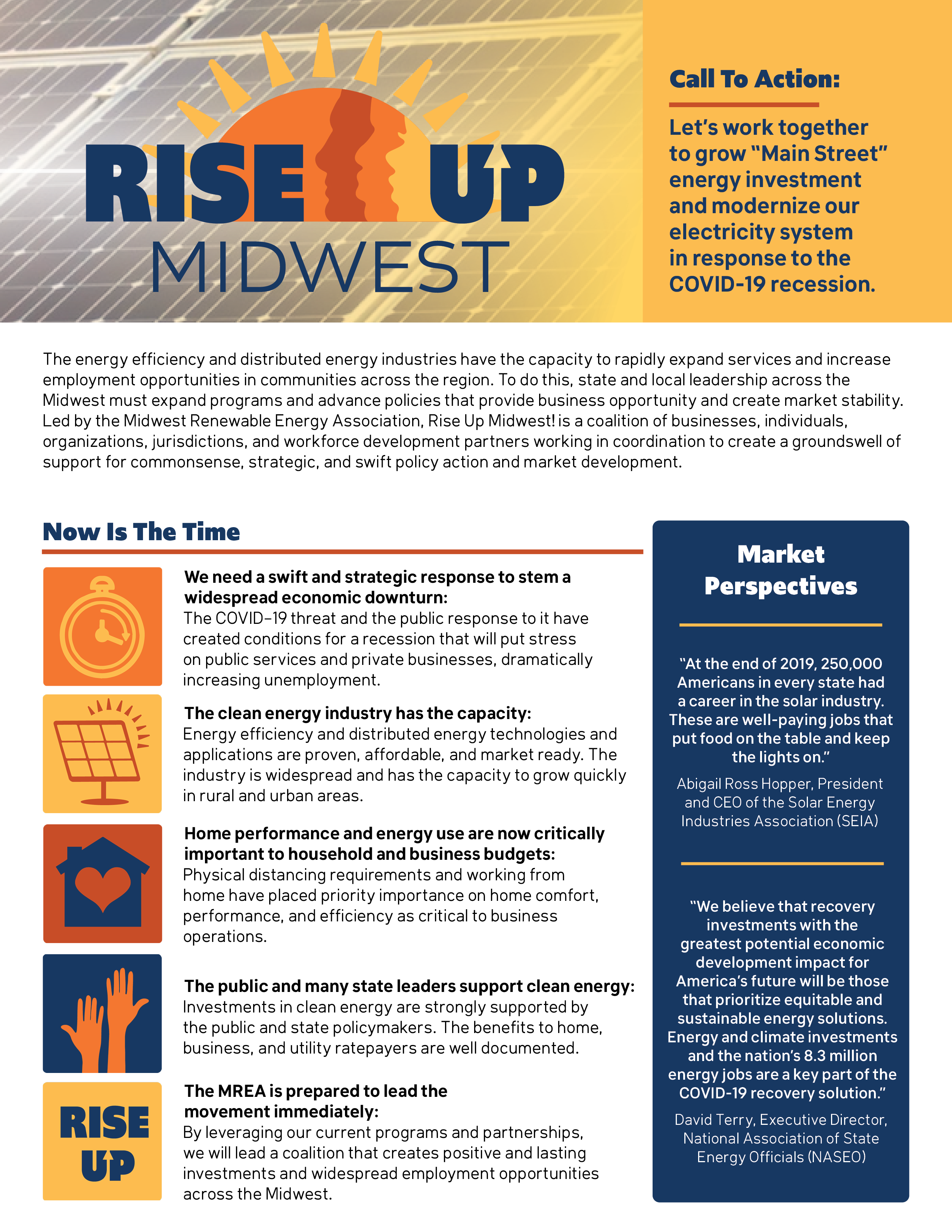Resource hub
Thanks for visiting!
Here you will find resources developed by MREA in support of the Rise Up movement. Below you will find a glossary to learn more about the Rise Up movement terminology. Stay tuned for our Rise Up Call to Action publication, as well as relevant partner and stakeholder resources. If you’re interested in advertising, please contact us at advertising@midwestrenew.org.
Let’s Connect:
Contact us with relevant community resources, educational material, podcasts, and more that you’d like to promote with Rise Up Midwest!
Please Share:
Rise Up Midwest! Promotional Flyer: This two page PDF provides a concise and brief overview of the Rise Up messaging, justification, organizing principles, and call to action.
GLOSSARY OF TERMS
MAIN STREET ENERGY INVESTMENT
When we refer to Main Street energy investment, we mean energy investment that is designed and intended to benefit most Midwest Americans – the middle class, the working class, the little guy, the small-business owner, etc. Main Street energy investment will save homeowners, business owners, schools, and cities money on operating expenses and electricity costs. These types of policies will not only make it more straightforward, but also more broadly financially accessible for Main Street to invest in renewable energy or energy efficiency projects. Main Street energy investment will create lasting financial savings for home and business owners while creating and maintaining well-paying jobs in a strong and growing industry.
MARKET BARRIERS
In general, market barriers refer to obstacles which prevent a product from gaining traction in a market. In the renewable and clean energy industries, these market barriers often take the form of policies detailing net metering, value of solar, financing, job training and more. For example, without access to third party financing, the availability of solar PV ownership is reduced largely to those than can finance the entire system upfront. Even though solar PV is often a cost-savings investment, those without good credit or access to large amounts of capital are unable to reap those savings. As such, those that could benefit most from the savings of solar PV (e.g. K-12 schools, low-income households), are those that are least likely to be able to move forward with a solar PV investment.
There is direct correlation between these types of policies and the level of renewable energy and energy efficiency adoption. How you fund renewables, how you value the energy they produce, and how the grid operates, all work together to encourage or discourage the adoption of these resources. Rise Up calls on state, local, and electric utility leadership throughout the Midwest to reduce these market barriers by advancing policies that facilitate the widespread deployment of energy efficiency and distributed energy resources to boost local investment, business growth, employment, and energy resiliency in rural and urban areas throughout the Midwest.
GRID MODERNIZATION
Grid modernization has become an all-encompassing phrase referring to changes needed in the electrical power grid to accommodate technological advancements happening in the generation, transmission, and distribution of electric power.
The grid consists of the utility’s network of conductors, substations, and equipment that distributes electricity from its “central” generation point to the consumer. A popular example of a “central” generation point is a coal fired power-plant. Our grid was conceptualized long before “distributed” generation technology was adopted or competitive. Examples of “distributed” generation technology are solar PV systems. Distributed meaning that these systems are generating electricity from rooftops to fields across the country, without a centralized generation point. As more utility interactive PV systems come online, grid modernization is essential.
A modernized grid will improve the communication and connectivity of distributed generation points and enable two-way communication and data flows, allowing operators to better understand the grid’s immediate operating status. By having this information, operators can run the grid closer to its full potential and capabilities, resulting in great efficiencies and reliability.
The Rise Up movement supports investing in a modernized grid, and the economic and resiliency benefits related to these improvements.
ENERGY RESILIENCY
Energy resilience is about ensuring people have a reliable and regular supply of energy and back-up measures in place in the event of a power failure. These failures can be caused by natural disasters, equipment failure, cyber-attacks, weather, and other factors. The expansion of distributed generation often works in tandem with energy resiliency.
Distributed energy resources like solar, not only complement centralized energy producers, but can provide resiliency services contributing to a smarter, more connected, and more automated electrical grid and distribution system. Microgrids, for example, can allow communities or institutions to disconnect from the larger electrical grid and maintain critical services during times like wildfire, high wind seasons, or widespread electrical outages.
Rise Up encourages greater energy resiliency with the inclusion of distributed energy and advancements to microgrid technology. This will, in turn, also create greater economic resiliency through job creation in the solar and clean energy supply chains.
DISTRIBUTED GENERATION
Distributed Generation (DG) refers to a variety of technologies that generate electricity at or near where it will be used. DG includes the full spectrum of customer owned or third-party owned electrical generation systems with examples including:
- Solar PV
- Wind
- Hydropower
- Biomass
- Combined heat and power systems
Solar PV is the most common and rapidly growing form of DG, and allow households, businesses, farms, and institutions to generate a portion of their own energy.
DG systems are subject to a different mix of local, state, and federal policies, regulations, and markets compared with centralized generation. As policies and incentives vary significantly from one place to another, the financial attractiveness of a DG project also varies.
NET METERING
Net Metering is a billing system that allows grid-tied customers who generate their own electricity from renewable energy systems to sell any surplus power produced back to the grid. This happens by spinning a ratepayer’s meter backward when more electricity is produced than consumed. For example, with solar PV, this process offsets the cost of electricity drawn from the grid both at night when the system is not producing and during periods when electricity consumption exceeds the system’s generation. In essence, a net metering arrangement subtracts any excess energy exported to the grid from the amount of energy imported from it.
Net metering is an important component to building a clean energy economy because it establishes substantial economic benefit to solar PV ownership, thus helping to increase demand for solar energy systems, which in turn creates jobs for the installers, electricians, and manufacturers who work in the solar supply chain. Additionally, increased distributed solar energy reduces strain on the grid by lessening peak demand and preventing losses from long distance transmission and distribution (SEIA).
Unfortunately, the availability of and details within existing net metering laws vary widely by state and utility. Some states and/or utilities offer net metering programs voluntarily, while others do so as a result of regulatory decisions. Net metering policies vary on system size limitations as well as how they compensate for excess generation; compensation can be made per kWh at a wholesale rate, value of solar rate, or at the full retail rate. The Rise Up movement strives for the establishment of universal net metering for all ratepayers served by investor-owned utilities.
ANNUAL TRUE-UP
A true-up statement is a form of net metering billing that utilities send to customers who generate electricity from distributed renewable energy. It reconciles the cumulative energy charges and credits the customer may be entitled to for that billing cycle. If there is a balance due after all charges and credits are reconciled, that amount will appear on your true-up statement. Dependent on the terms of the interconnection agreement, extra credits may reset to zero or be rolled over to the next billing cycle.
Some utility interconnection agreements offer an annual true-up, while others offer monthly or even instantaneous net metering compensation. An annual true-up comes at the end of the customer’s “12-month solar billing cycle,” which may fall either on the anniversary of the renewable energy system being connected to the grid or a predetermined date set forward by state legislature, dependent on state residency. An annual true-up looks at all the energy production and usage on a site throughout a calendar year and reconciles the charges based on the full year of data. This allows for fairer compensation and less confusion, versus that of a monthly true-up. An annual true-up is also beneficial to institutions such as schools that may be prone to seasonal energy use.
The Rise Up movement supports the establishment of universal “Annual True–Up” adoption to maximize the value of the energy produced by renewable energy systems.
THIRD-PARTY FINANCING
Third party solar financing is a financial agreement in which a third-party company is responsible for the costs of installing, operating, and maintaining a solar PV system throughout its lifetime, while the host customer agrees to having the system installed on their property, and, for a predetermined period of time, is responsible for either purchasing all the electricity the system produces (a power purchase agreement, or PPA) or paying a monthly premium to the solar company (a solar lease). In both cases, the customer’s electricity bill is offset by the solar PV system’s energy production. The availability of all types of third-party financing varies widely by state and utility.
Third party solar financing allows more customers to “go solar” and take advantage of the benefits of having a solar PV system on-site, by lowering or eliminating the upfront costs of purchasing the system. While commonly utilized for solar PV systems, third party financing can apply to other forms of renewable energy. The Rise Up movement is committed to supporting financing that promotes equitable access to solar and other forms of renewable energy by lowering costs for all consumers.
BE IN THE KNOW
Rise Up Podcast Season 5 Episode 12 — Solar In Minnesota and a Must-Attend Conference
Solar In Minnesota and a Must-Attend ConferenceSubscribe:Host:Nick Hylla, MREA Executive DirectorGuest:Logan O'Grady, Executive Director,...
Rise Up Podcast Season 5 Episode 11 — Fronius GEN24 Inverter and Roadshow
Fronius GEN24 Inverter and RoadshowSubscribe:Host:Nick Hylla, MREA Executive DirectorGuest:Chris Connell, Head of Solutions Management, Fronius...
Rise Up Podcast Season 5 Episode 10 — E-Bikes
E-BikesSubscribe:Host:Nick Hylla, MREA Executive DirectorGuest:Matthew Penniman, Communications and Advocacy Director, League of Michigan...
Rise Up Podcast Season 5 Episode 9 — Big Changes for Minnesota’s Community Solar Gardens
Big Changes for Minnesota’s Community Solar GardensSubscribe:Host:Nick Hylla, MREA Executive DirectorGuest:Peter Lindstrom, CERTs Manager of...
Rise Up Podcast Season 5 Episode 8 — Cold Climate Heat Pumps
Cold Climate Heat PumpsSubscribe:Host:Nick Hylla, MREA Executive DirectorGuest:Justin Margolies, Senior Product Developer,...
Rise Up Podcast Season 5 Episode 7 — The Basics of Photovoltaics
The Basics of PhotovoltaicsSubscribe:Host:Nick Hylla, MREA Executive DirectorGuest:Kris Schmid, Founder and Owner, Legacy Solar,...

contact us!
Address: 7558 Deer Rd. Custer, WI 54423
Email: info@riseupmidwest.org
Phone: 715-592-6595
The Midwest Renewable Energy Association (MREA) is a non-profit organization with the mission to promote renewable energy, energy efficiency, and sustainable living through education and demonstration.

